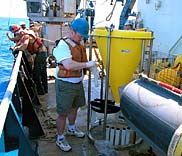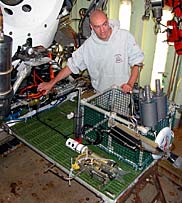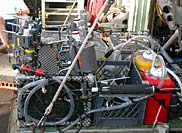|
|
|||||||||||||||||||||||||||||||||||||||||||||||||||||||||||||||||||||||||||||||||||||||||||||||||||
 |
|||||||||||||||||||||||||||||||||||||||||||||||||||||||||||||||||||||||||||||||||||||||||||||||||||
Today, Alvin performed a rescue mission for the last dive of the Lost City cruise. After yesterday’s dive, the Atlantis traveled about 140 nautical miles to the location of a sediment trap mooring with a faulty acoustic release. The dive objective was to descend to the bottom of the mooring at about 4000 meters and cut the cable that attached it to a 2000-pound weight, which anchored it to the sea floor. The sediment trap would then float to the surface, and could be retrieved by the Atlantis. The mooring consisted of the anchor, the sediment trap, glass floatation spheres to float the trap off the seafloor at 2800 meters depth, the acoustic release, and ¼ inch wire rope to attach all the pieces together into a line. The trap was deployed in January 2001, and was to be recovered last year. The mooring was supposed to disconnect from the cable anchoring it to the seafloor when an acoustic signal was sent to the release. Unfortunately the release failed on the first attempt, and another method of recovery was needed. We were going to be in the area, and were therefore convenient for a recovery.
The sediment trap is a big funnel that catches whatever might fall down into it from above. There is a rotary carousel at the bottom of the funnel that holds plastic collection bottles. Before the instrument is deployed, the user programs in the time required for each bottle to be indexed at the bottom of the funnel. I asked Tim Shank what this might be used for, and he responded, “The frequent goal of time-series sediment traps is to improve our understanding of how productivity (the growth of biological material such as plankton) is transported from the surface waters of the ocean down to the seafloor. Carbon from surface productivity can rain down to the deep sea and be a food source for many deep-sea animals. This patchy supply of descending food may then influence where animals live on different regions of the seafloor. Sediment traps can be very informative when deployed over different seasons, or during an oceanographic event such as following a surface plankton bloom.”
Blee was the pilot of the day and Noel was on a pilot-in-training dive. Since this dive did not have the same science objectives as the rest of the cruise, Debbie Kelley kindly allowed one of the ships crew to experience a trip to the bottom of the ocean, and First Engineer Gary McGrath was chosen from the Atlantis crew. This morning before the dive, I could easily see the giddy excitement in both Noel and Gary. It was nice to see their enthusiasm. Dive preparations consisted of a basket change last night. The normal science basket, consisting of bins to hold rocks, water sampling bottles, a temperature probe, and covered boxes to hold more delicate items such as biology, were all removed. A hydraulically operated cutter was then mounted along, with a backup manually actuated cutter. A few push cores were added to be used to sample the sediment at the base of the mooring. The normal science basket looks incongruous as part of this very technical submarine, although Dave Butterfield’s beast water sampler looks very complicated. Generally, plastic crates hold rocks. Hose clamps, wire ties, rubber bands, and bungee cord hold it all together, yet make it look kind of junky. But it is simplicity that makes a science basket most successful on a dive. The robotic manipulator is quite dexterous, but complicated maneuvers may be similar to trying to tie a knot in string while wearing gloves.
After the sub was launched, the dive proceeded routinely. The mooring's glass balls were good sonar targets and easily located via the subs forward-looking sonar. The sub went to the bottom of the mooring, where the push core sediment samples were taken. After sampling, the cable was cut using the hydraulic cutter. As the mooring started to float up to the surface, the sub was driven away to avoid any possibility of getting tangled. Following Alvin's recovery, the deck crew craned the mooring aboard. Tim removed the samples from the instrument and placed them in a refrigerator for storage. With our last task well done, we are now transiting towards our rendezvous with Bermuda. |
|||||||||||||||||||||||||||||||||||||||||||||||||||||||||||||||||||||||||||||||||||||||||||||||||||



